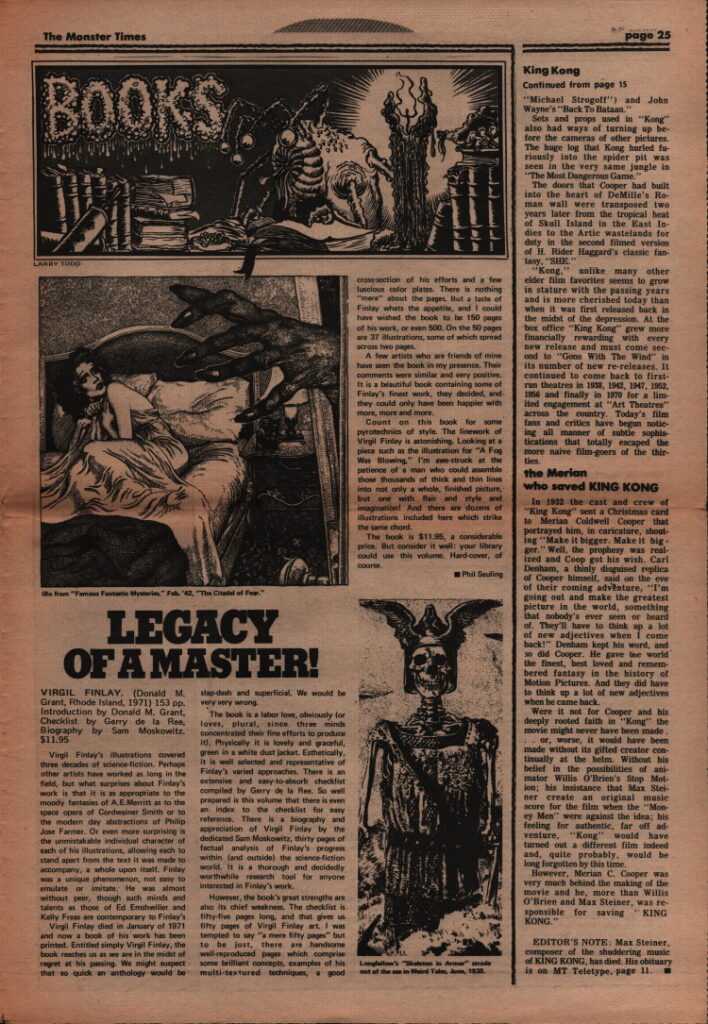
VIRGIL FINLAY. (Donald M. Grant, Rhode Island, 1971) 153 pp. Introduction by Donald M. Grant, Checklist by Gerry de la Ree, Biography by Sam Moskowitz. $11.95
Virgil Finlay’s illustrations covered three decades of science-fiction. Perhaps other artists have worked as long in the field, but what surprises about Finlay’s work is that it is as appropriate to the moody fantasies of A.E.Merritt as to the space opera of Cordwainer Smith or to the modern-day abstractions of Philip Jose Farmer. Or even more surprising is the unmistakable individual character of each of his illustrations, allowing each to stand apart from the text it was made to accompany, a whole upon itself. Finlay was a unique phenomenon, not easy to emulate or imitate. He was almost without peer, though such minds and talents as those of Ed Emshwiller and Kelly Freas are contemporary to Finlay’s
Virgil Finlay died in January of 1971 and now a book of his work has been printed. Entitled simply Virgil Finlay, the book reaches us as we are in the midst of regret at his passing. We might suspect that so quick an anthology would be slap-dash and superficial. We would be very very wrong.
The book is a labor love, obviously (or loves, plural, since three minds concentrated their fine efforts to produce it). Physically it is lovely and graceful, green in a white dust jacket. Esthetically, it is well selected and representative of Finlay’s varied approaches. There is an extensive and easy-to-absorb checklist compiled by Gerry de la Ree. So well prepared is this volume that there is even an index to the checklist for easy reference. There is a biography and appreciation of Virgil Finlay by the dedicated Sam Moskowitz, thirty pages of factual analysis of Finlay’s progress within (and outside) the science-fiction world. It is a thorough and decidedly worthwhile research tool for anyone interested in Finlay’s work.
However, the book’s great strengths are also its chief weakness. The checklist is fifty-five pages long, and that gives us fifty pages of Virgil Finlay art. I was tempted to say “a mere fifty pages” but to be just, there are handsome well-reproduced pages which comprise some brilliant concepts, examples of his multi-textured techniques, a good cross-section of his efforts and a few luscious color plates. There is nothing “mere” about the pages. But a taste of Finlay whets the appetite, and I could have wished the book to be 150 pages of his work, or even 500. On the 50 pages are 37 illustrations, some of which spread across two pages.
A few artists who are friends of mine have seen the book in my presence. Their comments were similar and very positive. It is a beautiful book containing some of Finlay’s finest work, they decided, and. they could only have been happier with more, more and more.
Count on this book for some pyrotechnics of style. The linework of Virgil Finlay is astonishing. Looking at a piece such as the illustration for “A Fog Was Blowing,” I’m awe-struck at the patience of a man who could assemble those thousands of thick and thin lines. into not only a whole, finished picture, but one with flair and style and imagination! And there are dozens of illustrations included here which strike the same chord.
The book is $11.95, a considerable price. But consider it well: your library could use this volume. Hard-cover, of course.
Phil Seuling
